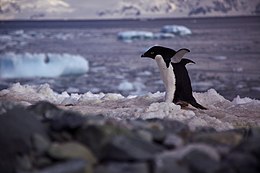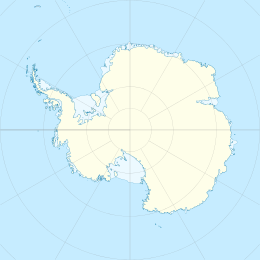geo.wikisort.org - Island
The Mackellar Islands, also MacKellar Islets, are a group of about 30 small islands and rocks lying 3 kilometres (1.5 nmi) north of Cape Denison in the center of Commonwealth Bay, George V Land, Antarctica. They were discovered by the Australasian Antarctic Expedition (1911–14) under Douglas Mawson, who named them for C.D. Mackellar of London, a patron of the expedition.[1] The largest is Greater Mackellar Island.
 Adélie penguins breed in the IBA | |
 Mackellar Islands Location in Antarctica | |
| Geography | |
|---|---|
| Location | Antarctica |
| Coordinates | 66°58′S 142°40′E |
| Total islands | 30 |
| Administration | |
| Administered under the Antarctic Treaty System | |
| Demographics | |
| Population | Uninhabited |
Important Bird Area
A 346 ha site comprising the island group and intervening sea has been designated an Important Bird Area (IBA) by BirdLife International because it supports colonies of Adélie penguins, totalling some 80,000 breeding pairs, an estimate based on 2011 satellite imagery. Other birds reported as breeding on the islands in small numbers include snow petrels, Wilson's storm petrels and south polar skuas.[2]
See also
- List of Antarctic and Subantarctic islands
References
- "Mackellar Islands". Geographic Names Information System. United States Geological Survey. Retrieved 2013-07-16.
- "MacKellar Islands". BirdLife Data Zone. BirdLife International. 2015. Retrieved 15 November 2020.
External links
- Sketch map
 This article incorporates public domain material from the United States Geological Survey document: "Mackellar Islands". (content from the Geographic Names Information System)
This article incorporates public domain material from the United States Geological Survey document: "Mackellar Islands". (content from the Geographic Names Information System)
На других языках
[de] Mackellar-Inseln
Die Mackellar-Inseln sind eine Gruppe aus rund 30 Inseln und Klippenfelsen vor der Georg-V.-Küste im Australischen Antarktis-Territorium. Sie liegen 2,5 km nördlich des Kap Denison im östlichen Teil Commonwealth-Bucht.- [en] Mackellar Islands
Другой контент может иметь иную лицензию. Перед использованием материалов сайта WikiSort.org внимательно изучите правила лицензирования конкретных элементов наполнения сайта.
WikiSort.org - проект по пересортировке и дополнению контента Википедии